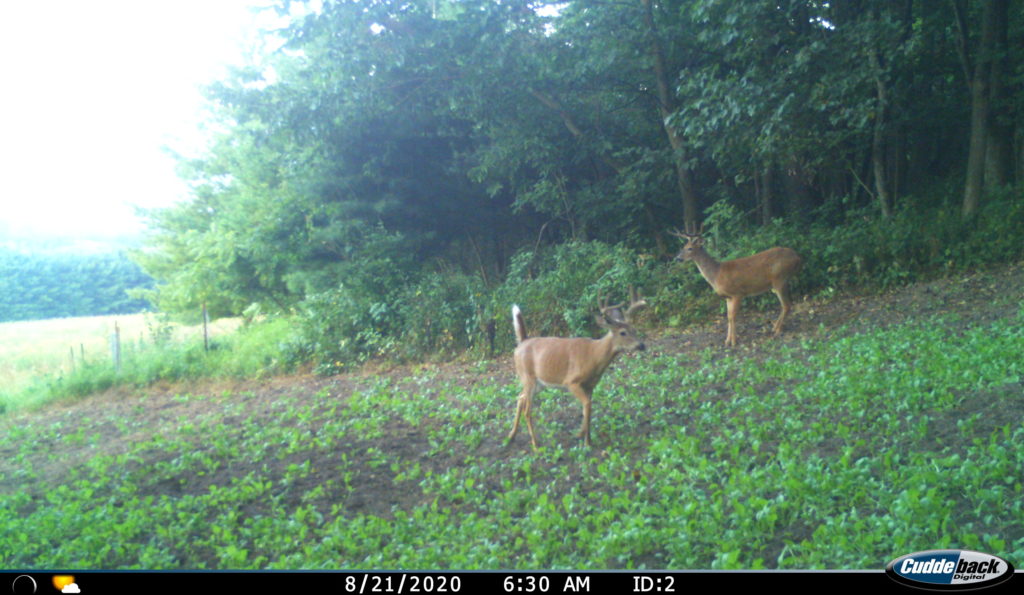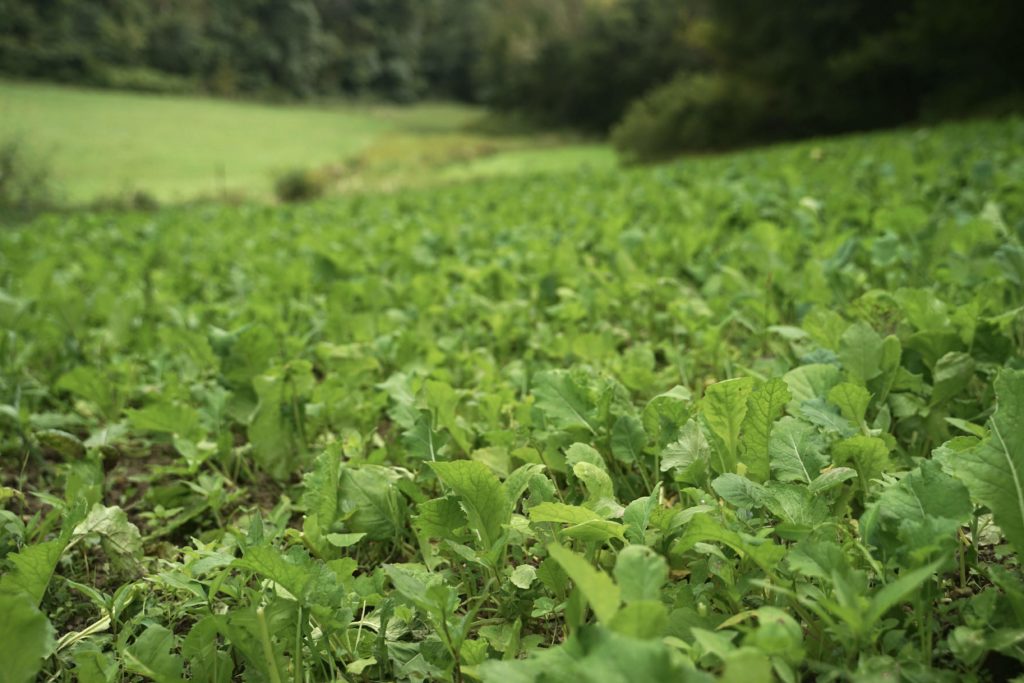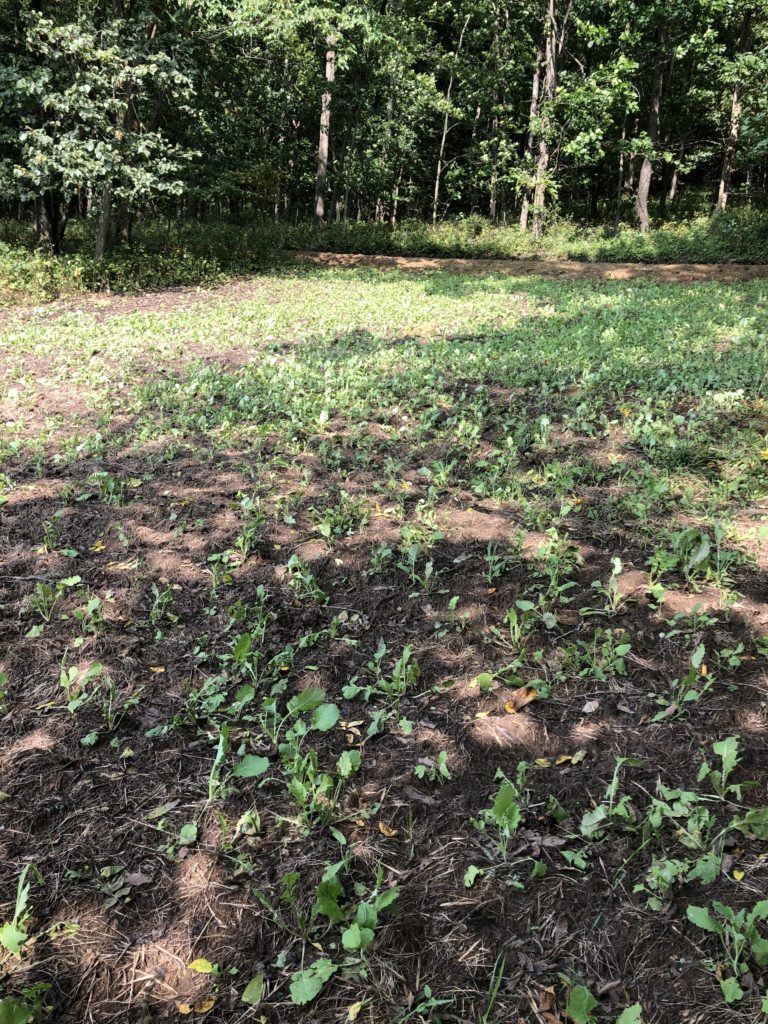Planting food plots can be a very therapeutic endeavor for the whitetail obsessed land manager and hunter. Let’s be honest, who doesn’t love hopping on a tractor with large equipment, or breaking out the hand tools to do a little food plotting. The rhythmic sound of seed being sent out of a hand crank spreader, the smell of humid summer air filled with a hint of freshly tilled soil, the constant drips of sweat raining from my baseball cap — there is nothing like the satisfaction of knowing your food plot work will feed whitetails.
Nearly every off-season, I enjoy trying new seed blends, and have come to realize the deer in my area absolutely crave plants from the brassica family. Turnips, radish, kale and other various brassica plants attract deer in the area I hunt unlike anything I’ve seen. Experienced food plotters understand there is a time and place for perennial food plots, but it’s hard to beat the draw of powerful annual food plot that lasts deep into the archery or firearms season. To be sure your hard work pays off, you’ll want to learn from a few of my own haphazard annual food plotting mistakes. Although brassicas can be a great attractant, many plants in the brassica family are susceptible to browse pressure if they are planted in a small plot. Let’s take a look at how plot size, browse pressure and plot diversity can play a role in successful brassica plantings.

How Small is Too Small?
Big, small or in the middle? Brassica food plots can fit the bill for many well-designed food plots if you consider herd numbers and complimentary plantings. In the summer of 2020, I decided to take a plot out of clover, so I sprayed and tilled it under to plant a brassica mix. The clovers were going on year four, and I was excited to plant brassicas knowing how well they had done in a larger plot. The new micro-plot was about 1/8 of an acre, and sandwiched between a large field enrolled in CRP (with corn below that), and a stand of timber with a large bedding ridge behind the plot. After planting on a tropically humid Wisconsin afternoon, the plot was in and ready for fall. The ‘kill plot’ stage had been set. Or so I thought.
Fast-forward five weeks, and the plot was coming in okay, but growth wasn’t happening like I thought it might. We hadn’t received a lot of rain, but enough where it should’ve been much taller. When I returned during hunting season, the plot was mostly a failure and had struggled to provide any sort of crop that you would deem successful. Despite the area being a natural staging and social area, I knew it wasn’t going to be all that spectacular.
READ: THE BEST BRASSICAS FOR DEER FOOD PLOTS
After checking the trail camera in late October, deer had clearly been using the plot — and browsing the daylights out of it. Deer had their heads down browsing in most photos. Deer love brassicas in my region. I should have known this plot was too small for a standalone plot of brassicas. The deer practically ate it to the dirt before they shed velvet. In the future, I would be hard-pressed to plant anything less than ½ acre in straight brassicas.

Browse Pressure
Depending on your food plot location, your plot might be used heavily during daylight hours and you should consider adding other forages into your mix. In order to put my plot failure into perspective, I asked John O’Brion, owner of Grandpa Ray Outdoors food plot seed, how someone should combat a primarily annual plot receiving high browse pressure. He said, “Many fall brassica plots are eaten down too early in the season. There are some strategies I share with clients to reduce this from happening. This includes adding annual clovers and multi-graze brassicas into blends to help with plot re-growth.” O’Brion said, “Some brassicas are multigraze, such as Winfred brassica, Bonar rape, Barkant turnip, Pacer brassica and Vivant brassica. In the case of Winfred brassica, when deer eat or graze on it, the plant tends to throw more branches, at times leaving plants with 8-16 branches per plant.”
Not only did I make the mistake of not providing a sort of ‘nurse’ crop to help my brassicas along, I haphazardly planted a blend without any consideration for its ability to withstand browse pressure. Food plotters typically place brassica in the nurse crop category, in order to help a fall planted clover, chicory or alfalfa plot establish. In my case, I should’ve added an aggressive growing annual clover such as Balansa Fixation or Frosty Berseem clover to help my brassica along for this small staging plot. O’Brion also told me, “Including annual clover in a brassica blend would fixate nitrogen, benefitting the following year’s planting. That free nitrogen helps reduce fertilizer costs and also helps maintain soil pH.”
For small and even large food plot failures, attempting to ‘rescue’ your plot is an option as well. Personally, my small food plot failure is a solid travel route regardless of an attractive forage existing. I decided not to plant a ‘rescue’ type of forage such as oats or winter rye, so I could frost seed clovers the following spring. For other food plotters who want to rescue a plot, O’Brion told me, “As you get past the mid-fall time period, you can consider over-seeding or re-drilling winter grains such as winter rye, winter wheat and winter triticale. You may also consider peas, oats and barley. These grains can still be planted as late as early October in much of the upper United States. You will not see a lot of tonnage as a result, but you will see effective browse.”

O’Brion said its always a good idea to plant brassicas that can withstand some grazing pressure. “Purple Top turnips, rutabaga, Daikon radish and other bulb-forming brassicas are not as graze tolerant to deer.” If you’re planning to establish a small bowhunting plot of mainly brassicas, consider your goals and if you want it to be standing tall and palatable to hunt over just a few days early in the season expecting to kill a buck, or if you want the plot to last well into the season to give you more window of opportunity. Increasing the number of plants in your food plot keeps something palatable for the deer all season.
Never Enough Diversity
Deer crave diverse habitats across their landscape. If your property has a great amount of diversity, you probably attract a lot of wildlife — and not just deer. Diversity is no different in the food plot world. Offer a wide array of plants maturing at different rates and succeeding in varying growing conditions, and you’ve got yourself a recipe for all-season attraction. If people are able, O’Brion suggests planting brassica fields in strips and offering many different forages within a plot of three strips. “For large fields of brassica — I strongly suggest people plant fields — one strip might contain a straight brassica blend. The other strips should include a brassica blend that is heavy in grains. The third strip would include a brassica blend with annual clovers. The strategy would then be to rotate those three strips each year to always give something back to the soil on two of the three strips.”
The King of Forages?
For many food plotters across the U.S., brassicas are either loved or hated. There is very little in between. Some landowners have great success while others in a different region or state simply cannot get deer to eat them. One thing is certain, if deer like brassicas, they will mow it down quickly if you do not plant appropriately. As John O’Brion said, planting a large field with diversity can be your ticket to an all-season attraction and could be better than doing a straight brassica blend regardless of whether your plot is a half acre or 3 acres. I hope you learn from my small plot failure and consider the many factors necessary for a successful brassica planting. Brassicas can truly be the king of forages when you hone in on the particulars.












































